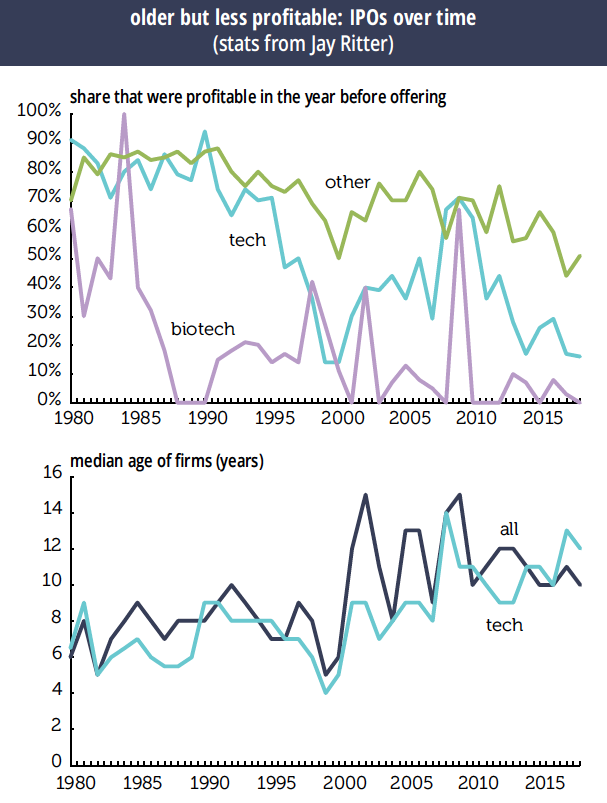The unicorns are finally going public in size after a long delay. Lyft did its IPO at the end of March, and Uber will be coming any day now. And more as the year goes on, flooding the San Francisco Bay Area with billions, and separating techno-optimists from large quantities money. It’s almost like 1999 again, minus the productivity acceleration (and pervasive euphoria).
Perhaps we’re being spoilsports, but this is all looking rather frothy. We’ve been worrying for some time about stock market high valuations, but an exuberance has been missing. Wacky IPOs might be a sign that the long bull market is finally entering its blowoff phase (though these can take some time).
Here are some stats from the leading academic authority on IPOs, Jay Ritter of the University of Florida. As the top graph below shows, there’s been a long-term decline in the share of firms making their market debut that were profitable. In the 1980s, 81% of tech firms going public were profitable; that fell to 14% in 1999–2000 but rose back to 38% from 2001–2007 (though obviously many fewer floated stock in the early 2000s than the late 1990s). But we got back to 16% in 2018. The profitable share of firms classed as “other” has almost always been higher, but it follows a similar path. Biotech firms are the least profitable, but they’re often swinging for the fences with a single product rather than trying to build a broad business.

As the lower graph shows, today’s market debutantes are generally much older than those of the dot.com era—an average of twelve years in 2018 compared to less than eight at the end of the 1990s. Uber, which lost $3 billion on revenues of $11 billion last year, and which shows no signs of becoming profitable any time soon, is ten years old. (As the company confesses in its prospectus, “we may not be able to achieve or maintain profitability in the near term or at all.”) You might think a firm that’s not making money after a decade or more of life and survives only on constant infusions of cash from venture capitalists might not have the best prospects for the future. But, as conceded above, perhaps we’re being spoilsports.
But maybe not. Ritter shows that since 1980, using a three-year buy-and-hold strategy, IPOs have underperformed the broad market by over 18 percentage points. Which makes one want to ask a VC, if this firm is such a great investment, why are you selling it?




